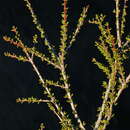en
names in breadcrumbs


Vail Lake ceanothus has a narrow geographical range, occurring in the Peninsular Ranges geographical province. It is a narrow endemic in the southwestern region of California [2,12]. It is known from 4 occurrences: 1 near Vail Lake, California, and 3 in the Agua Tibia Wilderness of the Cleveland National Forest, southern Riverside County [3,5,9,13]. Populations are separated by <3.5 miles (5.6 km ), and the species occupies <50 total acres (20 ha) [9].
States: CA [14]
Site Characteristics: Vail Lake ceanothus occurs on dry sites, including ridgetops and north- to northeast-facing rocky slopes, dry canyons, and stream edges. It only grows on shallow, phosphorus-deficient soils derived from weathered gabbro [2,9,10,12,13,16].
Vail Lake ceanothus occurs at 2,000 to 3,000 feet (600-900 m) elevation [2,10,12,13,16].
Plant Communities: Vail Lake ceanothus grows in chaparral communities dominated or codominated by chamise (Adenostoma fasciculatum) [13]. The Fire Regime Table lists the single plant community in which Vail Lake ceanothus may occur and provides some information on its fire regime. GENERAL INFORMATION ON BIOLOGY AND ECOLOGY, FIRE, AND MANAGEMENT Biology and ecology:The scientific name of Vail Lake ceanothus is Ceanothus ophiochilus S. Boyd, T.S. Ross, & Arnseth (Rhamnaceae) [2,12].
Hybrids:
Vail Lake ceanothus hybridizes with hoaryleaf ceanothus (C. crassifolius) where the 2 species occur together. Because hoaryleaf ceanothus is not adapted to the gabbroic soils to which Vail Lake ceanothus is endemic, viability of these hybrids may be poor [13,16].
Ceanothus ophiochilus is a rare species of flowering shrub known by the common name Vail Lake ceanothus, native to Southern California. It was not described until 1991.
The Ceanothus ophiochilus plant is endemic to California. It is only known from a few sites in the vicinity of Vail Lake and the Black Hills, east of Temecula and west of the Santa Rosa Mountains in southwestern Riverside County.[1]
Ceanothus ophiochilus is a plant of the chaparral plant community, and in its small native range which currently is only a few acres, it grows in pyroxenite soil atop an ancient volcano. Its elevation range is 580–1,065 metres (1,903–3,494 ft).[1]
One of the three remaining populations of this plant is on private property that may face development in the future. It was listed as a threatened species on the federal level in 1998, and an endangered species by the state of California in 1994.[1] There are up to 9000 individuals remaining, but some of these are hybrids with Ceanothus crassifolius.[2]
Ceanothus ophiochilus is an erect shrub reaching a maximum of 2 metres (6.6 ft) but generally shorter. The young twigs are reddish and grow gray with age. The tiny evergreen leaves grow opposite on the branches and sometimes grow in clusters, and rarely reach a centimeter in length. They are thick, firm, and shiny.
The shrub flowers in short inflorescences of pale blue to white to pale pink flowers during February and March.
This species grows only from seed, unlike other Ceanothus, which via an evolved fire ecology usually crown sprout from the lignotuber root crown after being reduced aboveground, such as by natural wildfires.
Ceanothus ophiochilus is cultivated by California native plant botanic gardens and plant nurseries, and available as an ornamental plant for: drought tolerant and native plant gardens, and natural landscape habitat gardens and larger landscape projects.
Ceanothus ophiochilus is a rare species of flowering shrub known by the common name Vail Lake ceanothus, native to Southern California. It was not described until 1991.